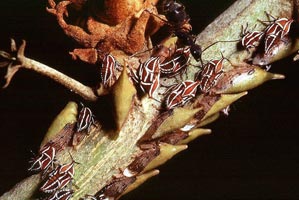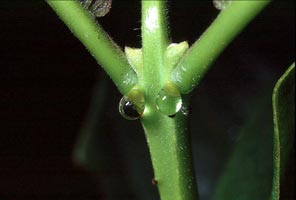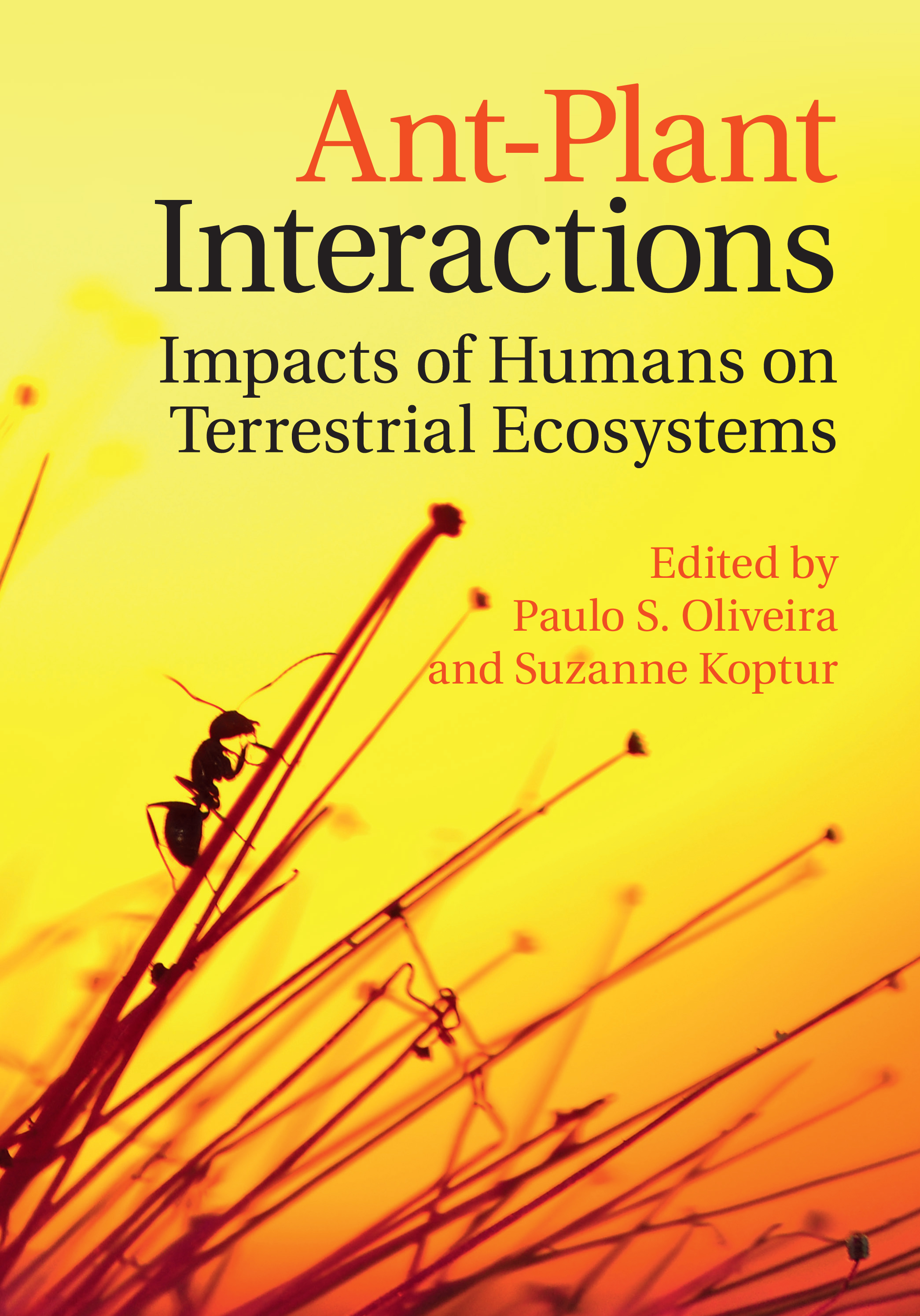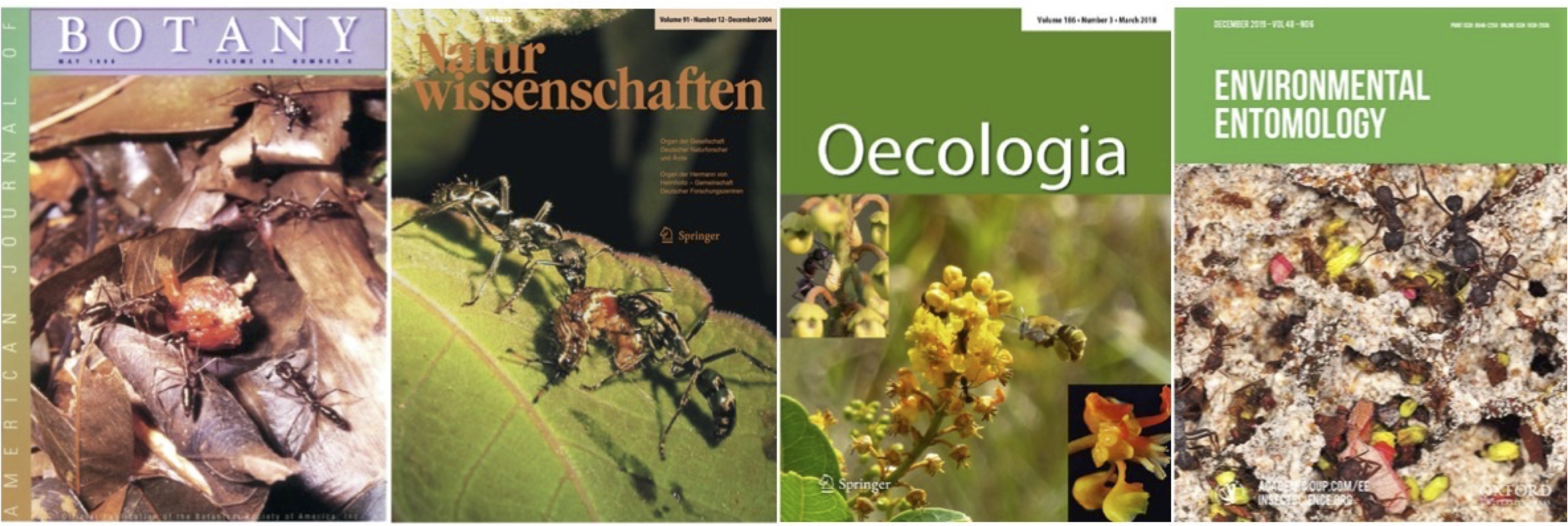|
|||||||||||||||||
|
|||||||||||||||||
|
|||||||||||||||||
|
|||||||||||||||||
| Master Program in Ecology 1 - Inara R. Leal - Behavioral ecology of Pachycondyla
(=Termitopone) marginata (Roger) (Hymenoptera: Formicidae):
group-raiding and migratory patterns. 1994 12 - Henrique Silveira - Chemical camouflage in the honeydew-producing treehopper Guayaquila xiphias (Hemiptera). 2008 13 - Pedro Rodrigues - Orientation in the neotropical arboreal ant Odontomachus hastatus (Formicidae: Ponerinae). 2009 14 - Daniel de Paiva Silva - Ecology and natural history of the stinkbug Edessa rufomarginata (Hemiptera: Pentatomidae). 2010 15 - Ceres Belchior. Behavioral ecology and natural history of the harvester ant, Pogonomyrmex naegelii (Formicidae, Myrmicinae): Activity rhythm, diet, home range, and nest structure. 2010. (Co-Advisor) 16 - Danilo Muniz. Ecology and natural history of Eunica bechina (Lepidoptera: Nymphalidae) in cerrado savanna. 2011 17 - Mayra C. Vidal. Predation of ants by Rhinoleucophenga (Diptera, Drosophilidae), and its effect on the mutualism between ants and Qualea grandiflora (Vochysiaceae). 2013 18 - Mariane U. V. Ronque. Natural history, behavior, and ecology of Camponotus rufipes and Camponotus renggeri (Formicidae: Formicinae): A comparative study in cerrado vegetation. 2013 19 - Luisa L. Mota. Ant-treehopper associations as visual cues for egg-laying Parrhasius polibetes (Lepidoptera: Lycaenidae), a facultative myrmecophilous butterfly. 2014. 20 - Javier Ibarra-Isassi. Interactions between ants, treehoppers, flowers, and flower visitors in cerrado vegetation: Experimental study with Byrsonima intermedia A. Juss (Malpighiaceae). 2016. 21 - Verônica B. S. Magalhães. Ants as secondary seed dispersers of Siparuna guianensis (Siparunaceae) in Cerrado savanna. 2016. 22 - Marianne Azevedo-Silva. Genetic diversity of ants (Hymenoptera: Formicidae) at colony and population scales: A comparative study of Camponotus renggeri and C. rufipes in Cerrado vegetation. 2017. 23 - Luis Francisco P. P. F. Salles. Edge effects on epigaeic arthropods in cerrado. 2017. 24 - Hélio Soares Jr. Natural history, behavior, and ecology of Camponotus leydigi (Hymenoptera: Formicidae) in cerrado vegetation. 2018 25 - Ana C. Calheiros. Social organization and foraging in the fungus-farming ant, Acromyrmex subterraneus (Hymenoptera: Formicidae). 2019 26 - Felipe P. Rocha. Bacterial communities associated with Odontomachus chelifer and O. hastatus (Hymenoptera: Formicidae): Evaluating species-specific and interhabitat effects. 2021. 27 - Aline Vieira Silva. The importance of the color pattern of Morpho helenor (Nymphalidae: Morphinae) in reducing predation by birds: An experimental approach. 2022.
8- Alexander Christianini - Ant-seed interactions in the cerrado savanna. 2007 9 - Claudia
Bottcher - The use of seeds and fruits by ants in the Atlantic rainforest:
Natural history, ecology, and spatial variation of a prominent interaction.
10 - Lucas A. Kaminski. Myrmecophily in Parrhasius polibetes (Lepidoptera: Lycaenidae): Natural history, costs, host-plant selection, and benefits of co-occurrence with myrmecophilous hemipterans. 2010. (Co-Advisor) 11 - Sebastián F. Sendoya. Spatial variation in multitrophic systems: Host plants and defense against ants in the Lepidoptera. 2012 12 - Ana Gabriela D. Bieber. Ant-fruit interactions and habitat fragmentation in the Atlantic rainforest. 2012 13 - Ana Z. Gonçalves. Ants in bromeliads: Cascading effects on the diversity of arthropods, nutrient cycling and ecophysiology of the host plants. 2016 (Co-Advisor) 14 - Mariane U. V. Ronque. Ecology, behavior and microbiology of fungus-farming ants (Formicidae, Myrmicinae, Attini, Attina) in Atlantic rainforest. 2018 15 – Marianne Azevedo-Silva. Ants, biodiversity and latitudinal gradient: Investigating interactions with plants, functional variation and genetic diversity in the Cerrado savanna. 2023 16 – Marília R. Bitar. Canopy dominant ant species and associated microbiota: Commensal adaptations to harsh environments. 2024 (Co-Advisor) |
|||||||||||||||||
|
|||||||||||||||||
|
|||||||||||||||||
|
|||||||||||||||||
|
|
|||||||||||||||||
|
|||||||||||||||||
|
Books
Oliveira, P.S. & Sazima, I. 1984. The adaptive bases of ant-mimicry in a neotropical aphantochild spider (Araneae: Aphantochilidae). Biological Journal of the Linnean Society, 22: 145-155. [PDF] Oliveira, P.S. 1985. On the mimetic association between nymphs of Hyalymenus spp. (Hemiptera: Alydidae) and ants. Zoological Journal of the Linnean Society, 83: 371-384. [PDF] Oliveira, P.S., Silva, A.F. da & Martins, A.B. 1987. Ant foraging on extrafloral nectaries of Qualea grandiflora (Vochysiaceae) in cerrado vegetation: ants as potential antiherbivore agents. Oecologia 74: 228-230. [PDF] Oliveira, P.S. 1988. Ant-mimicry in some Brazilian salticid and clubionid spiders (Araneae: Salticidae, Clubionidae). Biological Journal of the Linnean Society, 33: 1-15. [PDF] Oliveira, P.S. & Hölldobler, B. 1989. Orientation and communication in the Neotropical ant Odontomachus bauri Emery (Hymenoptera, Formicidae, Ponerinae). Ethology, 83: 154-166. [PDF] Oliveira, P.S. & Hölldobler, B. 1990. Dominance orders in the ponerine ant Pachycondyla apicalis (Hymenoptera: Formicidae). Behavioral Ecology and Sociobiology 27: 385-393. [PDF] Oliveira, P.S. & and Oliveira-Filho, A.T. 1991. Distribution of extrafloral nectaries in the woody flora of tropical communities in Western Brazil. In: Plant-Animal Interactions: Evolutionary Ecology in Tropical and Temperate Regions. P.W. Price, T.M. Lewinsohn, G.W. Fernandes & W.W. Benson (editors). John Wiley & Sons, New York. pp. 163-175. Oliveira, P.S. & Brandão, C.R.F. 1991. The ant community associated with extrafloral nectaries in Brazilian cerrados. In: Ant-Plant Interactions. Cutler, D.F. & Huxley, C.R. (editors). Oxford University Press, Oxford. pp. 198-212. Medeiros, F.N.S., Lopes, L.E., Moutinho, P.R.S., Oliveira, P.S. & Hölldobler, B. 1992. Functional polygyny, agonistic interactions and reproductive dominance in the neotropical ant Odontomachus chelifer (Hymenoptera, Formicidae, Ponerinae). Ethology 91: 134-146. [PDF] Fernandes, W.D., Oliveira, P.S., Carvalho, S.L. & Habib, M.E.M. 1994. Pheidole ants as potential biological control agents of the boll weevil, Anthonomus grandis (Coleoptera: Curculionidae), in Southeast Brazil. Journal of Applied Entomology 118: 437-441. [PDF] Leal, I.R. & Oliveira, P.S. 1995. Behavioral ecology of the neotropical termite-hunting ant Pachycondyla (=Termitopone) marginata: colony founding, group-raiding and migratory patterns. Behavioral Ecology and Sociobiology 37: 373-383. [PDF] Hölldobler, B., Janssen, E., Bestmann,
H.J., Leal, I.R., Oliveira, P.S., Kern, F., König, W.A. 1996. Communication
in the migratory termite-hunting ant Pachycondyla (=Termitopone) marginata (Formicidae, Ponerinae). Journal of Comparative Physiology 178: 47-53. [PDF] Del-Claro, K. & Oliveira, P.S. 1996. Honeydew flicking by treehoppers provides cues to potential tending ants. Animal Behaviour 51: 1071-1075. [PDF] Oliveira, P.S. 1997. The ecological function of extrafloral nectaries: herbivore deterrence by visiting ants and reproductive output in Caryocar brasiliense (Caryocaraceae). Functional Ecology 11: 323-330. [PDF] Castanho, L.M. & Oliveira, P.S. 1997. Biology and behaviour of the neotropical ant-mimicking spider Aphantochilus rogersi (Araneae: Aphantochilidae): nesting, maternal care and ontogeny of ant-hunting techniques. Journal of Zoology 242: 643-650. [PDF] Leal, I.R. & Oliveira, P.S. 1998. Interactions Between Fungus-Growing Ants (Attini), Fruits and Seeds in Cerrado Vegetation in Southeast Brazil. Biotropica 30: 170-178. [PDF] Pizo, M.A. & Oliveira, P.S. 1998. Interaction between ants and seeds of a nonmyrmecochorous neotropical tree, Cabralea canjerana (Meliaceae), in the Atlantic forest of Southeast Brazil. American Journal of Botany 85: 669-674. [PDF] Pizo, M.A. & Oliveira, P.S. 1999. Removal of seeds from vertebrate faeces by ants: effects of seed species and deposition site. Canadian Journal of Zoology 77:1595–1602. [PDF] Oliveira, P.S., Rico-Gray, V., Díaz-Castelazo, C, & Castillo-Guevara, C. 1999. Interaction between ants, extrafloral nectaries, and insect herbivores in Neotropical coastal sand dunes: Herbivore deterrence by visiting ants increases fruit set in Opuntia stricta (Cactaceae). Functional Ecology 13: 623-631. [PDF] Del-Claro, K. & Oliveira, P.S. 2000. Conditional outcomes in a neotropical treehopper-ant association: temporal and species-specific variation in ant protection and homopteran fecundity. Oecologia 124: 156-165. [PDF] Leal, I.R. & Oliveira, P.S. 2000. Foraging ecology of attine ants in a Neotropical savanna: seasonal use of fungal substrate in the cerrado vegetation of Brazil. Insectes Sociaux 47: 376-382. [PDF] Pizo, M.A. & Oliveira, P.S. 2000. The Use of Fruits and Seeds by Ants in the Atlantic Forest of Southeast Brazil. Biotropica 32(b): 851-861. [PDF] Queiroz, J.M. & Oliveira, P.S. 2001. Tending ants protect honeydew-producing whiteflies (Homoptera: Aleyrodidae). Environmental Entomology 30: 295-297. [PDF] Pizo, M.A. & Oliveira, P.S. 2001. Size and lipid content of nonmyrmecochorous diaspores: effects on the interaction with litter-foraging ants in the Atlantic rain forest of Brazil. Plant Ecology 157: 37-52. [PDF] Passos, L. & Oliveira, P.S. 2002. Ants affect the distribution and performance of Clusia criuva seedlings, a primarily bird-dispersed rainforest tree. Journal of Ecology 90: 517-528. [PDF] Oliveira, P.S., Freitas, A.V.L. & Del-Claro, K. 2002. Ant foraging on plant foliage: contrasting effects on the behavioral ecology of insect herbivores. In: The Cerrados of Brazil: Ecology and Natural History of a Neotropical Savanna. Oliveira, P.S. & Marquis R.J. (editors). Columbia University Press, NY. pp. 287-305. [PDF] Fourcassié, V. & Oliveira,
P. S. 2002. Foraging ecology of the giant Amazonian ant Dinoponera gigantea (Hymenoptera, Formicidae, Ponerinae): activity schedule, diet, and spatial
foraging patterns. Journal of Natural History 36: 2211-2227. [PDF] Cogni, R., Freitas, A.V.L., & Oliveira P.S. 2003. Interhabitat differences in ant activity on plant foliage: Ants at extrafloral nectaries of Hibiscus pernambucensis in sandy and mangrove forests. Entomologia Experimentalis et Applicata 107: 125-131. [PDF] Rico-Gray, V., Oliveira, P.S., Parra-Tabla, V., Cuautle, M. & Díaz-Castelazo, C. 2004. Ant-Plant Interactions: Their Seasonal Variation andEffects on Plant Fitness. In: Coastal Sand Dunes: Ecology and Restoration. Martínez M.L., Psuty, N. & Lubke, R. (editors). Springer-Verlag, Berlin. pp. 221-239. [PDF] Pizo, M.A., L. Passos & P.S. Oliveira. 2005. Ants as seed dispersers of fleshy diaspores in Brazilian Atlantic forests. In: Seed fate: Predation and secondary dispersal. P.-M. Forget, J. E. Lambert, P. E. Hulme & S. B. Vander Wall (editors.). CABI Publishing, Wallingford, Oxfordshire, UK. pp 315-329. [PDF] Cogni, R. & Oliveira P.S. 2004. Patterns in foraging and nesting ecology in the neotropical ant Gnamptogenys moelleri (Formicidae, Ponerinae). Insectes Sociaux 51:123-130. [PDF] Passos, L. & Oliveira, P.S. 2004. Interaction between ants and fruits of Guapira opposita (Nyctaginaceae) in a Brazilian sandy plain rainforest: ant effects on seeds and seedlings. Oecologia 139: 376-382. [PDF] Cogni, R. & Oliveira P.S. 2004. Recruitment behavior during foraging in the neotropical ant Gnamptogenys moelleri (Formicidae: Ponerinae): does the type of food matter. Journal of Insect Behavior 17:443-458. [PDF] Oliveira, P.S. & Freitas A.V.L. 2004. Ant-Plant-Herbivore Interactions in the Neotropical Cerrado Savanna. Naturwissenschaften 91:557-570. [PDF] Díaz-Castelazo, C., V. Rico-Gray, P.S. Oliveira & M. Cuautle. 2004. Extrafloral nectary-mediated ant-plant interactions in the coastal vegetation of Veracruz, Mexico: Richness, occurrence, seasonality and ant foraging patterns. Ecoscience 11:472-481. [PDF] Oliveira, P.S. & Del-Claro, K. 2005. Multitrophic interactions in a neotropical savanna: Ant-hemipteran systems, associated insect herbivores, and a host plant. In: Biotic Interactions in the Tropics. Burslem, DFRP, Pinard, MA & Hartley, SE (editors). Cambridge University Press, Cambridge, UK. pp. 414-438. [PDF] Pizo, M.A., P.R. Guimarães, Jr. & P.S. Oliveira. 2005. Seed removal by ants from faeces produced by different vertebrate species. Ecoscience 12:136-140. [PDF] Quental, T.B., J.R. Trigo & P.S.
Oliveira. 2005. Host-Plant Flowering Status and Sugar Concentration
of Phloem Sap: Effects on an Ant-Treehopper Interaction. European
Journal of Entomology 102:201-208. [PDF] Guimarães Jr., P.R., Rico-Gray,
V., Oliveira, P.S., Izzo, T.J., dos Reis, S.F. & Thompson, J.N.
2007. Interaction intimacy affects structure and coevolutionary dynamics
in mutualistic networks. Current Biology 17:1-7. [PDF] [PDF-supll] Kaminski, L. A., Sendoya, S.F., Freitas,
A.V.L., & Oliveira, P.S. 2009. Ecologia comportamental na interface
formiga-planta-herbívoro: Interações entre formigas
e lepidópteros. Oecologia Brasiliensis 13:27-44. [PDF] Silveira, H.C.P., Oliveira, P.S., & Trigo, J.R. 2010. Attracting predators without falling prey: Chemical camouflage protects honeydew-producing treehoppers from ant predation. American Naturalist 175:261-268. [PDF] Christianini, A.V . & Oliveira, P.S.
2010. Birds and ants provide complementary seed dispersal in a neotropical
savanna. Journal of Ecology 98:573–582. [PDF] Rodrigues, D., Kaminski, L.A., Freitas, A.V.L., & Oliveira, P.S. 2010. Trade-offs underlying polyphagy in a facultative ant-tended florivorous butterfly: the role of host plant quality and enemy-free space. Oecologia 163:719-728. [PDF] Kaminski, L.A., Freitas, A.V.L., & Oliveira, P.S. 2010. Interaction between mutualisms: Ant-tended butterflies exploit enemy-free space provided by ant-treehopper associations. American Naturalist 176:322-334. [PDF] Silva, D.P. & Oliveira, P.S. 2010. Field biology of Edessa rufomarginata (Hemiptera: Pentatomidae): Phenology, behavior, and patterns of host plant use. Environmental Entomology 39:1903-1910. [PDF] Oliveira, P. S., Camargo, R. X. & Fourcassié, V. 2011. Nesting patterns, ecological correlates of polygyny and social organization in the neotropical arboreal ant Odontomachus hastatus (Formicidae, Ponerinae). Insectes Sociaux 58:207–217. [PDF] Leal, I. R.; Silva, P. S. D., & Oliveira, P.S. 2011. Natural history and ecological correlates of fungus-growing ants (Formicidae: Attini) in the Neotropical cerrado savanna. Annals of the Entomological Society of America 104: 910-908. [PDF] Oliveira, P.S., Sendoya S.F., & Del-Claro, K. 2012. Defesas bióticas contra herbívoros em plantas do Cerrado: Interações entre formigas, nectários extraflorais e insetos trofobiontes. In: Ecologia das Interações Plantas-Animais: Uma Abordagem Ecológico-Evolutiva. K. Del-Claro & H. M. Torezan-Silingardi. (Editores). Rio de Janeiro: Technical Books. pp. 155-168. Christianini, A. V., Mayhé-Nunes, A. J., & Oliveira, P.S. 2012. Exploitation of Fallen Diaspores By Ants: Are There Ant-Plant Partner Choices? Biotropica 44:360-367. [PDF] Camargo, R. X. & Oliveira, P.S. 2012. Natural history of the Neotropical arboreal ant, Odontomachus hastatus (Formicidae, Ponerinae): Nest sites, foraging schedule, and diet. Journal of Insect Science 12: 48. [PDF] Moraes, A., Greeney H. F., Oliveira, P.S., Barbosa E. P., Freitas, A. V. L. 2012. Morphology and behavior of the early stages of the skipper Urbanus esmeraldus on an ant-visited host plant, Urera baccifera. Journal of Insect Science 12: 52. [PDF] Bächtold, A., Del-Claro, K., Kaminski, L. A., Freitas, A. V. L., & Oliveira, P. S. 2012. Natural history of an ant-plant-butterfly interaction in a Neotropical savanna. Journal of Natural History 46: 943-954. [PDF] Leal, I. R.; Silva, P. S. D., & Oliveira, P.S. 2012. Letter to the Editor. Annals of the Entomological Society of America 105: 509. [PDF] Muniz, D.G., Freitas, A.V.L. & Oliveira, P.S. 2012. Phenological relationships of Eunica bechina (Lepidoptera: Nymphalidae) and its host plant, Caryocar brasiliense (Caryocaraceae), in a Neotropical savanna. Studies on Neotropical Fauna and Environment 47: 111–118. [PDF] Belchior, C., Del-Claro, K. & Oliveira, P.S. 2012. Seasonal patterns in the foraging ecology of the harvester ant Pogonomyrmex naegelii (Formicidae, Myrmicinae) in a Neotropical savanna: Daily rhythms, shifts in granivory and carnivory, and home range. Arthropod-Plant Interactions 6:571–582. [PDF] Christianini, A.V. & Oliveira, P.S. 2013. Edge effects decrease ant-derived benefits to seedlings in a neotropical savanna. Arthropod-Plant Interactions 7:191-199. [PDF] Bieber, A.G.D., Silva, P.D. & Oliveira, P.S. 2013. Attractiveness of Fallen Fleshy Fruits to Ants Depends on Previous Handling by Frugivores. Écoscience 20:85-89. [PDF] Bieber, A.G.D., Silva, P.S.D., Sendoya S.F. & Oliveira, P. S. 2014. Assessing the Impact of Deforestation of the Atlantic Rainforest on Ant-Fruit Interactions: A Field Experiment Using Synthetic Fruits. Plos One, 9: e90369. [PDF] Christianini, A.V., Oliveira, P.S., Bruna, E.M. & Vasconcelos, H.L. 2014. Fauna in decline: Meek shall inherit. Science, 345: 1129. [PDF] Rodrigues, P.A.P. & Oliveira, P.S. 2014. Visual navigation in the Neotropical ant Odontomachus hastatus (Formicidae, Ponerinae), a predominantly nocturnal, canopy-dwelling predator of the Atlantic rainforest. Behavioural Processes 109:48-57. [PDF] Bottcher, C. & Oliveira, P.S. 2014. Consumption of lipid-rich seed arils improves larval development in a Neotropical primarily carnivorous ant, Odontomachus chelifer (Ponerinae). Journal of Tropical Ecology 30:621-624. [PDF] Sendoya S.F. & Oliveira, P.S. 2015. Ant-caterpillar antagonism at the community Level: Interhabitat variation of tritrophic interactions in a Neotropical savanna. Journal of Animal Ecology 84:442-452. [PDF] Azevedo-Silva, M., Mori, G.M. Souza, A.P. & Oliveira, P.S. 2015. Microsatellites for two Neotropical dominant ant species, Camponotus renggeri and C. rufipes (Hymenoptera: Formicidae). Conservation Genetics Resources 7:459-462. [PDF] Ronque, M.U.V., Azevedo-Silva, M., Mori, G.M., Souza, A.P. & Oliveira, P.S. 2016. Three ways to distinguish species: using behavioural, ecological, and molecular data to tell apart two closely related ants, Camponotus renggeri and Camponotus rufipes (Hymenoptera: Formicidae). Zoological Journal of the Linnean Society 176:170-181. [PDF] Sendoya, S.F., Blüthgen, N., Tamashiro, J.Y., Fernandez, F. & Oliveira, P.S. 2016. Foliage-foraging ants in a neotropical savanna: effects of plant and insect exudates on ant communities. Arthropod-Plant Interactions 10:183-195. [PDF] Gonçalves, A.Z., Oliveira, R.S., Oliveira, P.S. & Romero, G.Q. 2016. Species-specific effects of ant inhabitants on bromeliad nutrition. Plos One 11: e0152113. [PDF] Mota, L.L. & Oliveira, P.S. 2016. Myrmecophilous butterflies utilise ant-treehopper associations as visual cues for oviposition. Ecological Entomology 41:338-343. [PDF] Vidal, M.C., Sendoya, S.F. & Oliveira, P.S. 2016. Mutualism exploitation: Predatory drosophilid larvae sugar-trap ants and jeopardize facultative ant-plant mutualism. Ecology 97:1650–1657. [PDF] Bachtold, A., Kaminski L.A., Magaldi, L.M., Oliveira, P.S., Del-Claro, K., Janzen, D.H., Burns, J.M., Grishin, N., Hajibabaei, M., Hallwachs, W. & Freitas, A.V.L. 2017. Integrative data helps the assessment of a butterfly within the Udranomia kikkawai species complex (Lepidoptera: Hesperiidae): Immature stages, natural history, and molecular evidence. Zoologischer Anzeiger 266:169-176. [PDF] Breviglieri, C.P.B., Oliveira, P.S. & Romero, G.Q. 2017. Fear mediates trophic cascades: nonconsumptive effects of predators drive aquatic ecosystem function. American Naturalist 189:490-500. [PDF] Cuquetto-Leite, L., Dolder, H., Oliveira, P.S., Espirito-Santo, N.B., Lino-Neto, J. & Mancini, K.C. 2017. Structural and Ultrastructural Characterization of the Spermatozoa in Pachycondyla striata and P. marginata (Hymenoptera: Formicidae: Ponerinae. Insectes Sociaux 64:209–217. [PDF] Gonçalves A.Z., Srivastava D.S., Oliveira, P.S. & Romero, G.Q. 2017. Effects of predatory ants within and across ecosystems in bromeliad food webs. Journal of Animal Ecology 86:790–799. [PDF] Oliveira, P.S. & Koptur, S. 2017. Ants and plants: A prominent interaction in a changing world. In: Ant-Plant Interactions: Impacts of Humans on Terrestrial Ecosystems, Oliveira, P.S. & Koptur, S. (editors). pp. XV- XIX. Cambridge University Press, Cambridge, UK. Oliveira, P.S., Christianini, A.V., Bieber, A.G.D., & Pizo, M.A. 2017. Anthropogenic disturbances affect the interactions between ants and fleshy fruits in two Neotropical biodiversity hotspots. In: Ant-Plant Interactions: Impacts of Humans on Terrestrial Ecosystems, Oliveira, P.S. & Koptur, S. (editors). pp. 133-156. Cambridge University Press, Cambridge, UK. Sendoya, S.F & Oliveira, P.S. 2017. Behavioural ecology of defence in a risky environment: Caterpillars versus ants in a Neotropical savanna. Ecological Entomology 42: 553-556. [PDF] Ronque, M.U.V., Fourcassié, V. & Oliveira, P.S. 2018. Ecology and field biology of two dominant Camponotus ants (Hymenoptera: Formicidae) in the Brazilian savannah. Journal of Natural History 52: 237-252. [PDF] Ibarra-Isassi, J. & Oliveira, P.S. 2018. Indirect effects of mutualism: ant-treehopper associations deter pollinators and reduce reproduction in a tropical shrub. Oecologia 186: 691-701. [PDF] Ronque, M.U.V., Migliorini, G.H., & Oliveira, P.S. 2018. Thievery in rainforest fungus-growing ants: Interspecific assault on culturing material at nest entrance. Insectes Sociaux 65: 507-510. [PDF] Magalhaes, V.B., Espírito Santo, N.B., Salles, L.F.P., Soares Jr, H. & Oliveira, P.S. 2018. Secondary seed dispersal by ants in Neotropical cerrado savanna: Species-specific effects on seeds and seedlings of Siparuna guianensis (Siparunaceae). Ecological Entomology 43: 665–674. [PDF] Vidal, M.C., Sendoya S.F., Yamaguchi, L.F., Kato, M.J., Oliveira, R.S. & Oliveira, P.S. 2018. Natural history of a sit-and-wait dipteran predator that uses extrafloral nectar as prey attractant. Environmental Entomology 47: 1165–1172. [PDF] Salles, L.F.P., Christianini, A.V. & Oliveira, P.S. 2018. Dirt roads and fire breaks produce no edge effects on litter-dwelling arthropods in a tropical dry-forest: a case study. Journal of Insect Conservation 22:647-657. [PDF] Camargo, P., Christianini, A.V., Piratelli, A., Oliveira, P.S. & Rodrigues, S. 2019. Interhabitat variation in diplochory: Seed dispersal effectiveness by birds and ants differs between Atlantic forest and Cerrado savanna. Perspectives in Plant Ecology, Evolution and Systematics 38:48-57. [PDF] Ronque, M.U.V., Feitosa, R.M. & Oliveira, P.S. 2019. Natural history and ecology of fungus-farming ants: a field study in Atlantic rainforest. Insectes Sociaux 66:375-387. [PDF] Calheiros, A.C., Ronque, M.U.V., Soares, Jr, H., & Oliveira, P.S. 2019. Field biology and foraging ecology of the leaf-cutter ant Acromyrmex subterraneus (Hymenoptera: Formicidae) in Neotropical Cerrado savanna. Environmental Entomology 48:1434-1441. [PDF] Calheiros, A.C., Ronque, M.U.V., & Oliveira, P.S. 2019. Social organization and subcaste specialization in the leaf-cutting ant Acromyrmex subterraneus (Formicidae: Myrmicinae). Journal of Insect Behavior 32:267-280. [PDF] Azevedo-Silva, M., Mori, G.M., Carvalho, C.S., Côrtes, M.C., Souza. A.P., Oliveira, P.S. 2020. Breeding systems and genetic diversity in tropical carpenter ant colonies: different strategies for similar outcomes in Brazilian Cerrado savanna. Zoological Journal of the Linnean Society 190:1020–1035. [PDF] Ronque, M.U.V., Lyra, M.L., Migliorini, G.H., Bacci M., Oliveira, P.S. 2020. Symbiotic bacterial communities in rainforest fungus-farming ants: evidence for species and colony specificity. Scientific Reports 10:10172. [PDF] Lemos, A. S. M.; Azevedo-Silva, M.; Gonçalves-Neto, S.; Souza, A.P. & Oliveira, P.S. 2020. Microsatellites for the Neotropical Ant, Odontomachus chelifer (Hymenoptera: Formicidae). Journal of Insect Science 20(5):1- 6. [PDF] Gonçalves-Neto, S., Azevedo-Silva, M., Lemos, A.S.M. Souza, A.P., & Oliveira, P.S. 2021. Microsatellites for the Neotropical Ant, Camponotus leydigi (Hymenoptera: Formicidae). Entomological Science 24:79-84. [PDF] Soares Jr, H. & Oliveira, P.S. 2021. Foraging and spatial ecology of a polydomous carpenter ant, Camponotus leydigi (Hymenoptera: Formicidae), in tropical Cerrado savanna: A natural history account. Environmental Entomology 50:19-27. [PDF] Freitas, A.V.L., Muniz, D.G., Carreira, J.Y.O. & Oliveira, P.S. 2021. Fruit-feeding butterfly assemblages in a Neotropical savanna: Assessing phenological patterns using baited traps. Journal of the Lepidopterists’ Society 75:88-103. [PDF] Dáttilo, W., Serio-Silva, J.C., Thompson, J.N., Del-Claro, K., Guimarães, P.R., Oliveira, P.S., Jordano, P., Marquis, R.J., & Koptur, S. 2021. In remembrance of Victor Rico Gray (1951-2021): An astonishing tropical ecologist. Biotropica 53:1238-1243. [PDF] Silva, R.R., Martello, F., Feitosa, R.M., Silva, O., Prado, L., Brandão, C.R.F., Albuquerque, E., Morini, M., Delabie, J., Monteiro, E., Ribeiro, M., et al., Oliveira, P.S., et al. 2022. Atlantic ants: a dataset of ants in Atlantic forests of South America. Ecology 103 (2) e03580. [PDF] Koptur, S., Clayborn, J., Harris, B., Jones, I., Pimienta, M.C., Primoli, A.S., & Oliveira, P.S. 2022. Caterpillar responses to ant protectors of plants. In: Caterpillars in the Middle. Marquis R.J. and S. Koptur (eds). Springer, Berlin. pp 297–317. doi:10.1007/978-3-030-86688-4_10 [PDF] Pereyra, M., Zeballos, S.R., Galetto, L., & Oliveira. P.S. 2022. Influence of secondary dispersal by ants on invasive processes of exotic species with fleshy fruits. Biological Invasions 24: 3275-3289. [PDF] Rocha, F.P., Ronque, M.U.V., Lyra, M.L., Bacci, M., & Oliveira, P.S. 2023. Habitat and Host Species Drive the Structure of Bacterial Communities of Two Neotropical Trap-Jaw Odontomachus Ants. Microbial Ecology 86:699-712. [PDF] Azevedo-Silva, M., Lemos, A.S.M., Gonçalves-Neto, S., Salles, L.P.S., Pereyra, M., Christianini, A.V., Souza, A.P., & Oliveira, P.S. 2023. Are There Edge Effects on the Genetic Diversity of the Trap-Jaw Ant Odontomachus chelifer (Formicidae: Ponerinae) in a Neotropical Savanna Fragment? A First Assessment. Environmental Entomology 52: 279–285. [PDF] Azevedo-Silva, M., Côrtes, M.C., Carvalho, C.S., Mori, G.M., Souza, A.P., & Oliveira, P.S. 2023. Landscape genetics in a highly threatened environment: how relevant to ants is the physiognomic mosaic of the cerrado savanna? Conservation Genetics. 24: 709-719. [PDF] Bottcher, C., Berthelot, K., Bernadou, A., Orivel, J., Fourcassié, V., Oliveira, P.S. & Jeanson, R. 2024. Colony structure, ecological correlates and nestmate recognition in the ant Odontomachus hastatus: A comparative study between populations with different social organizations. Insectes Sociaux 71: 61-73. [PDF] Bitar, M.R.; Tome, L.R.; Costa, F.V.; Kato, R.B.; Oliveira, P.S.; Goes-Neto, A.; Ribeiro, S.P. 2024. Bacterial communities associated with a polydomous arboreal ant: inter-nest variation and interaction with the phyllosphere of a tropical tree. Myrmecological News, 34: 119-127. [PDF] Vieira-Silva, A., G.B. Evora, A.V.L. Freitas, P.S. Oliveira. 2024. The Relevance of Flash Coloration Against Avian Predation in a Morpho Butterfly: A Field Experiment in a Tropical Rainforest. Ethology 130: 1-9. [PDF] Azevedo-Silva, M., Sendoya, S.F., Côrtes, M.C., Longo, P.A.S., Nogueira, A., Mori, G.M., Hirota, S.K., Suyama, Y., Souza, A.P., & Oliveira, P.S. 2025. Sugar-Rich Resources Mediate Geographic Morphological Variation in a Dominant, Neotropical Savanna Ant. Journal of Biogeography, 52: e15111. [PDF]
|
|||||||||||||||||







